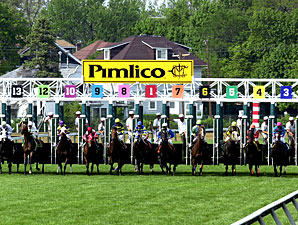Growth in Export Handle Helps Pimlico Meet

Growth in out-of-state wagering on its product helped Pimlico Race Course record an increase in average daily pari-mutuel handle for the 2014 spring meet.
The Maryland Jockey Club June 10 reported average daily handle of $4.69 million for the meet that ended June 7, up 4.7% from $4.47 million in 2013. There were 35 live racing days this year versus 36 last year.
The average includes wagering on imported signals, according to MJC statistics. Total in-state handle for the meet was $34.7 million, down 10.6% from $38.9 million in 2013. Wagering on live racing was down 5.3% from $12.9 million to $12.3 million, while wagering on full-card simulcasts was down 10.6% from $38.9 million to $34.7 million.
Out-of-state wagering on the Maryland races, however, increased 3.8% to $146.3 million from $141 million last year, according to MJC statistics. Average daily out-of-state handle on Pimlico racing was $4.17 million, up 6.7% from $3.91 million in 2013.
"We had a strong finish with our numbers up 14 times during the last 16 days of the meet," MJC president Tom Chuckas said in a release. "Despite running one fewer day, we had more total runners this year, so the racing department deserves a great deal of credit."
According to The Jockey Club Information Systems, Pimlico averaged 7.81 horses per race, up from 7.47 for the 2013 spring meet. Purses this year totaled $14.44 million, up from $13.67 million last year. Purses averaged $412,630 a day in 2014 versus $379,810 in 2013, according to TJCIS.
Maryland racing receives a percentage of revenue from casino video lottery terminals for purses and capital improvements.
The May 17 Preakness Stakes (gr. I) program generated total handle of $83.78 million, while the May 16 Black-Eyed Susan Stakes (gr. II) program produced total wagering of $11.34 million.
"We would have shattered the Black-Eyed Susan day attendance and handle records set a year ago if not for the two inches of rain that hit Baltimore that morning which caused six races to come off the turf and discouraged attendance," Chuckas said. "But I am still proud of what we have done to improve the Preakness weekend, and we will continue to find ways to sustain the momentum through the end of the meet and beyond."
Live Thoroughbred racing in Maryland takes a break until it returns at the Maryland State Fair at Timonium in late August, followed by the late summer/fall meet at Laurel Park.
